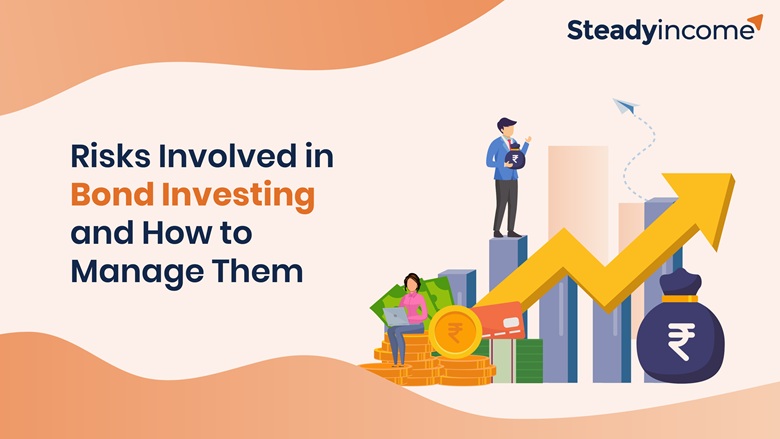Risks Involved in Bond Investing and How to Manage Them

Introduction to Bond Investing
When it comes to creating a stable and balanced investment portfolio, bonds play a crucial role. Whether you're a conservative investor or looking for passive income streams, bonds offer a predictable return compared to more volatile assets like stocks. However, even though bonds are generally considered safer, they're not risk-free. Understanding the risks involved in bond investing and knowing how to manage them is key to long-term success, especially in dynamic markets like India.
In the world of personal finance, bond investment is often seen as the safer cousin of stock investing. Bonds offer fixed returns, preserve capital, and add stability to an investor’s portfolio. But make no mistake—bonds are not risk-free. Just like any other investment vehicle, they carry certain risks that can affect your returns.
What Are Bonds?
At their core, bonds are loans you give to governments or companies, and in return, they promise to pay you interest at regular intervals and repay your principal at maturity. This predictable nature makes them popular. But several factors can impact your returns and even your principal.
Top Risks in Bond Investing
1. Interest Rate Risk
The risk: When interest rates rise, the market value of your existing bonds falls. This is because new bonds offer better returns, making your lower-yielding bonds less attractive.
Solution:
-
- Invest in short-term bonds to decrease sensitivity to interest rate fluctuations.
- Consider a bond ladder, where bonds mature at staggered intervals.
- Monitor the interest rate cycle and rebalance your holdings accordingly.
2. Credit Risk
The risk: The issuer may fail to make interest payments or repay the principal. This is especially common in corporate bonds with lower credit ratings.
Solution:
-
- Invest in high-quality, investment-grade bonds.
- Always check credit ratings (like CRISIL or ICRA).
- Use verified platforms like Steadyincome, which curate and filter credible bond options.
3. Inflation Risk
The risk: If inflation rises faster than your bond yield, the purchasing power of your interest income drops.
Solution:
-
- Choose inflation-protected bonds or bonds with fluctuating interest rates.
- Diversify into asset classes that perform well during inflationary periods.
4. Liquidity Risk
The risk: Some bonds are difficult to sell quickly without impacting their price, especially if they’re unlisted or less traded.
Solution:
-
- Stick to listed bonds or those with higher market demand.
- Opt for bond platforms like Steadyincome, where liquidity details are transparent.
- Keep some capital in liquid instruments for emergencies.
5. Call Risk
The risk: Issuers may redeem the bond before maturity, especially when interest rates fall. This limits your interest income and may force you to reinvest at lower rates.
Solution:
-
- Avoid bonds with call features or check call conditions before investing.
- If unavoidable, factor this risk into your return expectations.
6. Reinvestment Risk
The risk: You may have to reinvest interest or matured capital at lower rates than you initially earned.
Solution:
-
- Stagger investments using a bond laddering strategy.
- Keep a mix of short-term and long-term bonds to spread reinvestment over different rate cycles.
7. Market Risk
The risk: Even bonds can fluctuate due to market sentiment, geopolitical issues, or economic conditions.
Solution:
-
- Don’t panic-sell.
- Hold quality bonds until maturity to minimize the impact of market volatility.
How to Mitigate Bond Risks Effectively
Bond investing goes beyond simply looking for high returns—it's about making smart, risk-aware decisions that align with your financial goals. It’s about balancing risk and reward. Here’s how you can take control of your bond investments:
A. Diversify Your Bond Holdings
Don’t put all your eggs in one basket. Spread investments across:
-
- Government bonds (low risk)
- PSU bonds (moderate risk)
- Corporate bonds (higher return, higher risk)
- Varying maturities and sectors
Diversification protects your portfolio if one issuer defaults or a sector underperforms.
B. Invest via a Trusted Platform
Platforms like Steadyincome simplify bond investing by:
-
- Offering handpicked, pre-evaluated bond options
- Providing credit rating transparency
- Showing expected returns and maturity timelines
- Offering expert insights and investor education
This ensures that you're not navigating risk alone.
C. Monitor and Review Your Portfolio
Bond markets are dynamic. Interest rates, inflation, and creditworthiness can change. Regularly review:
-
- Credit ratings
- Yield changes
- Maturity profiles
- Market developments
Adjust your portfolio as needed.
D. Consult a Financial Advisor
If you're unsure about managing bond risks on your own, a financial advisor or bond specialist can help customize a fixed-income strategy based on your risk appetite and goals.
Why Choose Steadyincome for Bond Investment?
At Steadyincome, our goal is to make fixed-income investing accessible, transparent, and profitable. Whether you’re interested in listed corporate bonds, PSU bonds, or fractional ownership of high-quality debt instruments, we provide:
-
- Verified listings
- Clear credit ratings and disclosures
- Easy-to-use interface
- Research support for confident decision-making
Join a growing community of investors who are earning steady returns while minimizing risk.
Final Thoughts
Bonds can be a solid foundation for wealth-building, especially when approached with awareness and strategy. By understanding the different risks—from interest rate and credit risk to inflation and liquidity concerns—you’ll be in a better position to protect your capital and generate consistent returns.
With tools, insights, and trusted listings available on Steadyincome, your bond investment journey can be smart, strategic, and successful.
Ready to start investing smarter in bonds? Explore verified opportunities at steadyincome.


